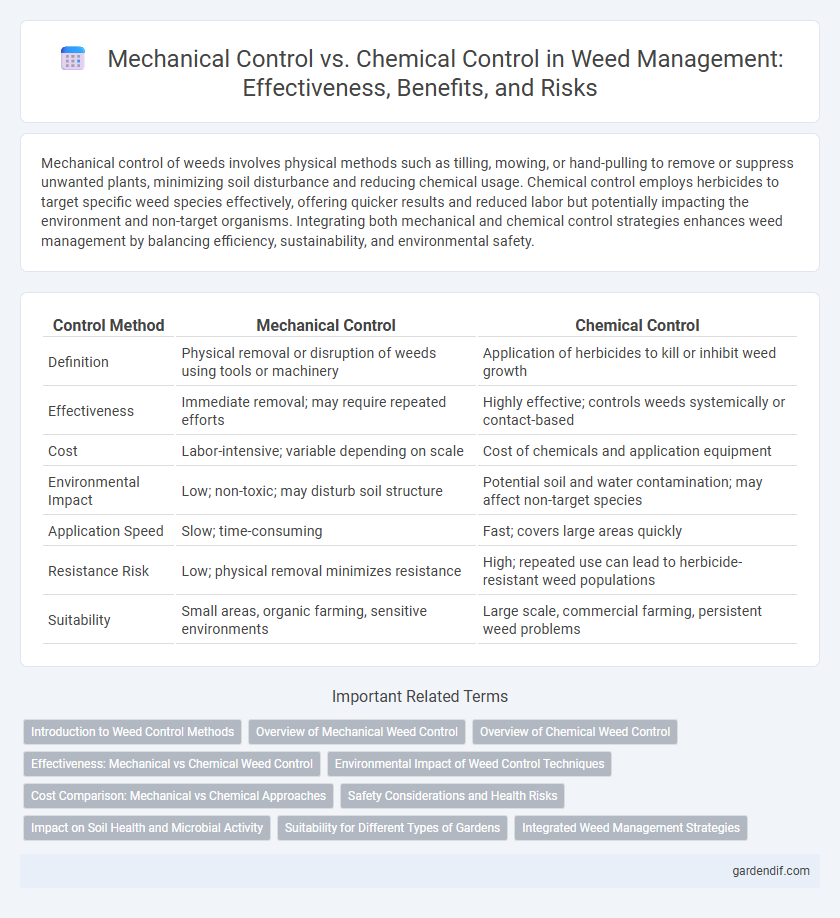
Mechanical control vs Chemical control Illustration
Mechanical control of weeds involves physical methods such as tilling, mowing, or hand-pulling to remove or suppress unwanted plants, minimizing soil disturbance and reducing chemical usage. Chemical control employs herbicides to target specific weed species effectively, offering quicker results and reduced labor but potentially impacting the environment and non-target organisms. Integrating both mechanical and chemical control strategies enhances weed management by balancing efficiency, sustainability, and environmental safety.
Table of Comparison
| Control Method | Mechanical Control | Chemical Control |
|---|---|---|
| Definition | Physical removal or disruption of weeds using tools or machinery | Application of herbicides to kill or inhibit weed growth |
| Effectiveness | Immediate removal; may require repeated efforts | Highly effective; controls weeds systemically or contact-based |
| Cost | Labor-intensive; variable depending on scale | Cost of chemicals and application equipment |
| Environmental Impact | Low; non-toxic; may disturb soil structure | Potential soil and water contamination; may affect non-target species |
| Application Speed | Slow; time-consuming | Fast; covers large areas quickly |
| Resistance Risk | Low; physical removal minimizes resistance | High; repeated use can lead to herbicide-resistant weed populations |
| Suitability | Small areas, organic farming, sensitive environments | Large scale, commercial farming, persistent weed problems |
Introduction to Weed Control Methods
Mechanical control methods for weeds involve physical techniques such as tilling, mowing, and hand-pulling to remove or destroy unwanted plants without harmful residues. Chemical control utilizes herbicides that target specific weed species, providing rapid and effective suppression but carrying risks of environmental impact and resistance development. Integrated weed management combines both approaches to optimize control efficacy and sustainability in agricultural and horticultural settings.
Overview of Mechanical Weed Control
Mechanical weed control involves physical methods such as tilling, hoeing, mowing, and hand-pulling to remove or suppress unwanted plants. It minimizes herbicide use by disrupting weed growth cycles and reducing seed bank populations in the soil. This approach enhances soil aeration and can be integrated with crop rotation to improve overall weed management sustainability.
Overview of Chemical Weed Control
Chemical weed control involves the targeted application of herbicides to manage unwanted vegetation, offering precise and efficient results. Herbicides are classified into selective and non-selective types, each designed to target specific weed species while minimizing damage to desired crops. This method enables large-scale weed management with reduced labor input, but requires careful consideration of environmental impact and resistance development.
Effectiveness: Mechanical vs Chemical Weed Control
Mechanical weed control effectively reduces weed populations by physically removing or disrupting weed growth, making it ideal for small-scale or organic farming systems. Chemical weed control offers faster and broader-spectrum weed suppression through herbicides, often leading to higher immediate efficacy in large-scale agricultural operations. Combining both methods enhances long-term weed management by reducing herbicide resistance and improving overall crop yields.
Environmental Impact of Weed Control Techniques
Mechanical control of weeds minimizes chemical runoff and soil contamination, promoting biodiversity and enhancing soil health by preserving beneficial organisms. Chemical control methods, though effective for rapid eradication, often contribute to groundwater pollution, non-target species harm, and the development of herbicide-resistant weed populations. Integrated weed management combining mechanical and chemical techniques reduces environmental impact while maintaining effective weed suppression.
Cost Comparison: Mechanical vs Chemical Approaches
Mechanical control methods for weed management typically incur higher labor and equipment maintenance costs compared to chemical control, especially in large-scale operations. Chemical control often offers lower upfront expenses and faster application, but ongoing costs for herbicides and potential resistance management can increase long-term expenditures. Evaluating cost-effectiveness depends on factors such as weed species, infestation levels, and environmental regulations affecting herbicide use.
Safety Considerations and Health Risks
Mechanical control of weeds minimizes exposure to harmful pesticides, reducing potential health risks for workers and surrounding ecosystems. Chemical control, while often more efficient, presents significant safety concerns such as toxic residue, inhalation hazards, and potential contamination of soil and water sources. Proper handling, use of personal protective equipment, and adherence to safety guidelines are critical to mitigate health risks associated with herbicides.
Impact on Soil Health and Microbial Activity
Mechanical control methods, such as tilling and hand-weeding, disrupt weed growth while preserving soil structure and promoting microbial diversity, essential for nutrient cycling and soil fertility. Chemical control involving herbicides can reduce microbial populations and alter soil enzyme activities, potentially leading to decreased soil health and organic matter decomposition. Sustainable weed management often integrates mechanical techniques to maintain robust soil microbial communities and enhance long-term soil productivity.
Suitability for Different Types of Gardens
Mechanical control suits small to medium-sized gardens with manageable weed populations, offering a chemical-free approach that minimizes environmental impact. Chemical control is more effective in large-scale or heavily infested gardens where rapid and extensive weed management is necessary, but requires careful selection of herbicides to match specific weed species and garden types. Integrating both methods can optimize weed control, tailoring strategies to garden size, weed density, and plant sensitivity.
Integrated Weed Management Strategies
Mechanical control involves physical methods such as tillage and mowing to disrupt weed growth, promoting soil health and reducing weed seed banks. Chemical control uses herbicides targeting specific weed species but risks resistance and environmental impact. Integrated Weed Management Strategies combine both approaches with cultural and biological methods to enhance efficacy, sustainability, and reduce reliance on chemicals.
Mechanical control vs Chemical control Infographic

 gardendif.com
gardendif.com